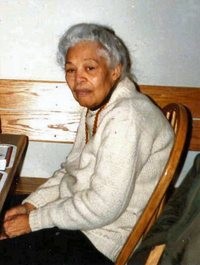Ann Lane was born on October 12, 1908 in Old Saybrook, Connecticut as the youngest of three daughters to Peter Clark Lane and Bertha James Lane in Old Saybrook, Connecticut. Her parents belonged to the black minority of the small town. Her father was a pharmacist and her mother was a shop owner, chiropodist, and hairdresser. Ann and her sister were raised "in the classic New England tradition: a study in efficiency, thrift, and utility (…) They were filled with ambitions that they might not have entertained had they lived in a city along with thousands of poor blacks stuck in demeaning jobs."
The family had none of the trappings of the middle class until Petry was well into adulthood. Before her mother became a businesswoman, she worked in a factory, and her sisters, Ann's aunts, worked as maids. The Lane girls were raised sheltered from most of the disadvantages other black people in the United States had to experience due to the color of their skin; however there were a number of incidents of racial discrimination.
As she wrote in "My Most Humiliating Jim Crow Experience," published in Negro Digest in 1946, there was an incident where a racist decided that they did not want her on a beach. Her father wrote a letter to The Crisis in 1920 or 1921 complaining about a teacher who refused to teach his daughters and his niece.[citation needed] Another teacher humiliated her by making her read the part of Jupiter, the illiterate ex-slave in the Edgar Allan Poe short story "The Gold-Bug".
Petry had a strong family foundation with well-traveled uncles, who had many stories to tell her when coming home; her father, who overcame racial obstacles, opened a pharmacy in the small town; and her mother and aunts who set a examples to become strong herself. Petry, interviewed by the Washington Post in 1992, says about her tough female family members that “it never occurred to them that there were things they couldn’t do because they were women.
The wish to become a professional writer was raised in Ann for the first time in high school when her English teacher read her essay to the class commenting on it with the words: “I honestly believe that you could be a writer if you wanted to.”[4] The decision to become a pharmacist was her family’s. She enrolled in college and graduated with a Ph.G. degree from Connecticut College of Pharmacy in New Haven in 1931 and worked in the family business for several years. She also began to write short stories while she was working at the pharmacy.
On February 22, 1938, she married George D. Petry of New Iberia, Louisiana, which brought Petry to New York. She not only wrote articles for newspapers such as The Amsterdam News, or The People’s Voice, and published short stories in The Crisis, but also worked at an after-school program at P.S. 10 in Harlem. It was during this period of her life that she had realized and personally experienced what the black population of the United States had to go through in their everyday life.
Traversing the streets of Harlem, living for the first time among large numbers of poor black people, seeing neglected children up close – Petry’s early years in New York inevitably made impressions on her. Impacted by her Harlem experiences, Ann Petry used her creative writing skills to bring this experience to paper. Her daughter Liz explained to the Washington Post that “her way of dealing with the problem was to write this book, which maybe was something that people who had grown up in Harlem couldn’t do.”
Petry’s most popular novel The Street was published in 1946 and won the Houghton Mifflin Literary Fellowship. With The Street, Petry became the first black woman writer with book sales topping a million copies
Back in Old Saybrook in 1947, the writer worked on Country Place (1947), The Narrows (1953), other stories, and books for children, but they have never achieved the same success as her.
3 works Add another?
![]() Sorted by:
Most Editions
|
First Published
|
Most Recent
|
Top Rated
|
Reading Log
|
Random
Sorted by:
Most Editions
|
First Published
|
Most Recent
|
Top Rated
|
Reading Log
|
Random
Showing all works by author. Would you like to see only ebooks?
Ann Petry
×Close
Subjects
American literature, Anglo-Saxons, Children's fiction, Drama, Fiction, Juvenile audience, Mystery and detective stories, Private investigators, amorality, aristocracy, detective fiction, locked-room mysteries, Children: Young Adult (Gr. 7-9), Elementary and junior high school, English literature, Juvenile Nonfiction, Literary Criticism & Collections, Readers (Secondary), Study and teaching (Middle school), study and teachingID Numbers
- OLID: OL2632739A
- ISNI: 0000000114367004
- VIAF: 2489917
- Wikidata: Q448736
- Inventaire.io: wd:Q448736
Links (outside Open Library)
No links yet. Add one?
| May 12, 2023 | Edited by Lisa | reverted to revision 6 |
| April 1, 2022 | Edited by JeneeWhitney | merge authors |
| September 27, 2020 | Edited by MARC Bot | add ISNI |
| May 14, 2017 | Edited by MARC Bot | merge authors |
| April 29, 2008 | Created by an anonymous user | initial import |



